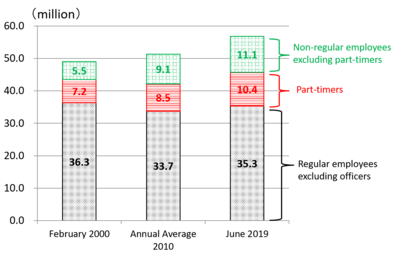Column Finance and the Social Security System 2020.01.30
【Aging, safety net and fiscal crisis in Japan】No.213: Labor unions are deteriorating
The Ministry of Health, Labor and Welfare released a report of the Labor Union Basic Survey in December, 2019. The total number of employees in the country has almost doubled from 32.8 million in June, 1970 to 60.2 million in June, 2019. However, members of labor unions have fallen from 11.6 million to 10.1 million (Figure 1) in the same period. There are two reasons for this contradictory phenomenon. First, the reputation of unions as life security agencies is decreasing among employees. Second, the increase in the number of total employees can be attributed to an increase in the number of non-regular employees (Figure 2). Non-regular employees are classified as part-timers and others (temporary staffs, contract workers, etc.). As of June, 2019, only 8.1% of 10.4 million part-timers joined labor unions. Therefore, the organization rate, which is calculated by dividing the number of labor union members by the number of employees, has decreased from 35.4% in 1970 to 16.7% in 2019 (Figure 3). The number of labor unions has also decreased from 34,232 in 1980 to 24,067 in 2019 (Figure 4).
Figure 1 Number of employees and labor union members

(Source)Labor Union Basic Survey 2019, Ministry of Health, Labor and Welfare
Figure 2 Number of regular employees and non-regular employees

(Source)Labor Union Basic Survey 2019, Ministry of Health, Labor and Welfare
Figure 3 Rate of organization of labor unions

(Source)Labor Union Basic Survey 2019, Ministry of Health, Labor and Welfare
Figure 4 Number of labor unions

(Source) Labor Union Basic Survey 2019, Ministry of Health, Labor and Welfare
